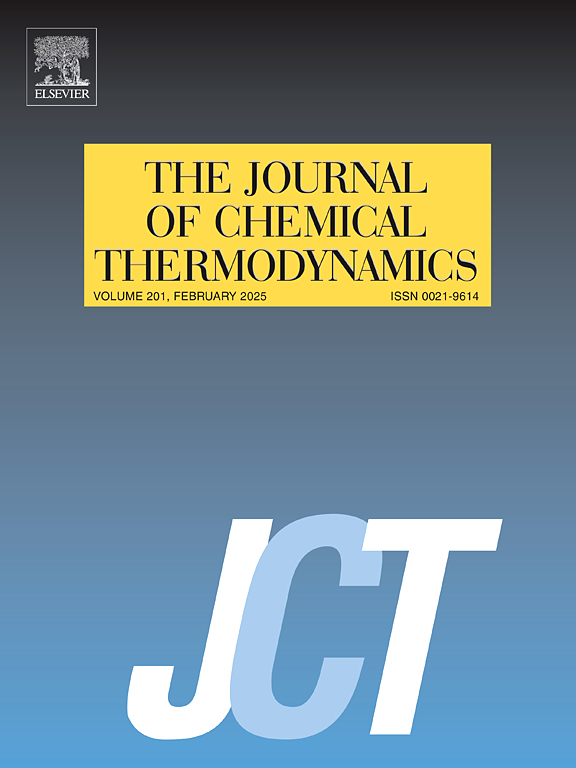Exploring molecular interactions through thermophysical properties and molecular dynamics simulations in [Emim][NTf2] and 2-EE mixtures
IF 2.2
3区 工程技术
Q3 CHEMISTRY, PHYSICAL
引用次数: 0
Abstract
In this study, we explored the thermophysical properties of a mixture composed of 1-ethyl-3-methylimidazolium bis(trifluoromethylsulfonyl)imide ([Emim][NTf2]) ionic liquid (IL) and the organic solvent 2-ethoxyethanol (2-EE). We meticulously measured the density, speed of sound, and refractive index across the full range of mixture compositions at temperatures of 298.15, 303.15, 308.15, 313.15, and 318.15 K under atmospheric pressure. Additionally, we calculated various excess parameters, such as excess molar volume, excess isentropic compressibility, excess isobaric thermal expansion coefficient, deviation in refractive index, and partial molar quantities, based on our experimental data. These parameters were then analyzed using the Redlich-Kister polynomial equation to understand the mixture's behavior better. Our findings revealed strong attractive forces within the IL-rich areas of the [Emim][NTf2] and 2-EE binary mixture, indicating significant intermolecular interactions. The strength and nature of these interactions were further supported and illuminated through ATR-FTIR and Molecular Dynamics (MD) simulation studies, providing a comprehensive insight into the molecular dynamics within these mixtures.

通过[Emim][NTf2]和2-EE混合物的热物理性质和分子动力学模拟探索分子相互作用
在这项研究中,我们探索了由1-乙基-3-甲基咪唑双(三氟甲基磺酰基)亚胺([Emim][NTf2])离子液体(IL)和有机溶剂2-乙氧基乙醇(2-EE)组成的混合物的热物理性质。在298.15、303.15、308.15、313.15和318.15 K的大气压下,我们仔细地测量了混合成分的密度、声速和折射率。此外,我们还根据实验数据计算了各种多余参数,如多余摩尔体积、多余等熵压缩系数、多余等压热膨胀系数、折射率偏差和部分摩尔量。然后使用Redlich-Kister多项式方程对这些参数进行分析,以更好地了解混合物的行为。我们的研究结果显示,在[Emim][NTf2]和2-EE二元混合物中富含il的区域内存在强大的吸引力,表明存在显著的分子间相互作用。通过ATR-FTIR和分子动力学(MD)模拟研究,进一步支持和阐明了这些相互作用的强度和性质,为这些混合物中的分子动力学提供了全面的见解。
本文章由计算机程序翻译,如有差异,请以英文原文为准。
求助全文
约1分钟内获得全文
求助全文
来源期刊

Journal of Chemical Thermodynamics
工程技术-热力学
CiteScore
5.60
自引率
15.40%
发文量
199
审稿时长
79 days
期刊介绍:
The Journal of Chemical Thermodynamics exists primarily for dissemination of significant new knowledge in experimental equilibrium thermodynamics and transport properties of chemical systems. The defining attributes of The Journal are the quality and relevance of the papers published.
The Journal publishes work relating to gases, liquids, solids, polymers, mixtures, solutions and interfaces. Studies on systems with variability, such as biological or bio-based materials, gas hydrates, among others, will also be considered provided these are well characterized and reproducible where possible. Experimental methods should be described in sufficient detail to allow critical assessment of the accuracy claimed.
Authors are encouraged to provide physical or chemical interpretations of the results. Articles can contain modelling sections providing representations of data or molecular insights into the properties or transformations studied. Theoretical papers on chemical thermodynamics using molecular theory or modelling are also considered.
The Journal welcomes review articles in the field of chemical thermodynamics but prospective authors should first consult one of the Editors concerning the suitability of the proposed review.
Contributions of a routine nature or reporting on uncharacterised materials are not accepted.
 求助内容:
求助内容: 应助结果提醒方式:
应助结果提醒方式:


